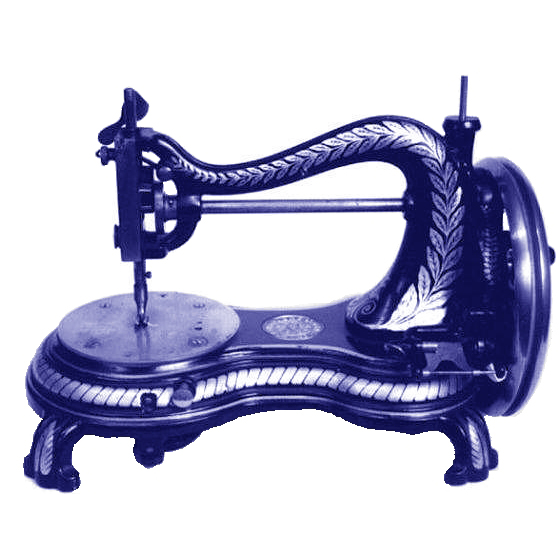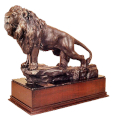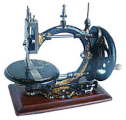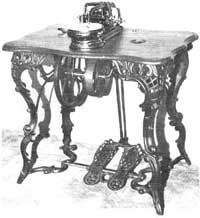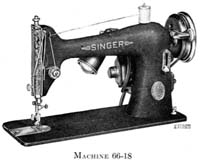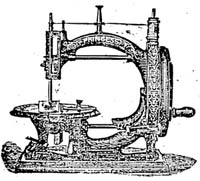The Essex Sewing Machine Company
Origins in Wartime Innovation
The story of the Essex Sewing Machine Company represents a fascinating chapter in post-war British industrial history. Unlike many of the larger sewing machine manufacturers with 19th century origins, Essex emerged from the unique economic conditions following World War II.
The company began in 1935 as a small workshop that specialized in repairing mechanical gambling devices, including "one-arm bandits" and pintables. This seemingly modest enterprise, located in Wanstead, London, would later pivot in a direction that contributed significantly to domestic sewing in post-war Britain.
When World War II erupted, the company, like many British manufacturing operations, was redirected toward the war effort. Between 1940 and 1945, their mechanical expertise was applied to manufacturing precision tools, gauges, and components for military weapons. This period proved crucial in developing the company's capabilities in precision engineering that would later benefit their sewing machine production.
Post-War Opportunity
The aftermath of World War II created unique market conditions across Britain. Consumer goods were in short supply, and many households faced long waiting lists for essential items. Sewing machines, critical for home clothing production during a time of continued rationing, were particularly difficult to obtain.
In this environment of scarcity, the management at Essex identified a promising opportunity. Having examined a toy sewing machine imported from America, they conceptualized what would become their signature product: not merely a toy, but a compact, affordable, and functional machine suitable for adult use. Their aim was to create what they termed "a small cheap but effective adult version" of a sewing machine.
The Essex Miniature Sewing Machine was born in 1946, with production based at 12 Nelson Road in Wanstead, London E11. The company leveraged their wartime experience in precision engineering to create a machine that, while small, was built to professional standards of durability and function.
The Essex MK1: Technical Features
The first model, designated the Essex MK1, revealed the influence of established designs, particularly the Singer 20. While the similarities were evident, the Essex engineers incorporated their own refinements to create a machine that was more than a mere copy.
The MK1 produced a single-thread chain stitch, a relatively simple mechanism that eliminated the need for a bobbin or shuttle system. This design choice made the machine more straightforward to produce and maintain, though the resulting stitch pattern was not as secure as the lock stitch found in larger machines. On the reverse side of fabric, the machine created a delicate decorative pattern characteristic of chain stitch technology.
From a technical perspective, the MK1 utilized standard 15x1 (2020) sewing needles, which were threaded from left to right. This compatibility with widely available needles proved to be a significant practical advantage for users, ensuring supplies remained accessible even during times of scarcity.
Despite its diminutive size, the Essex machine was engineered with quality components that delivered reliable performance. Marketing materials emphasized that this was not a toy but rather a practical tool for everyday sewing tasks, capable of producing stitches of professional quality.
Commercial Success and Evolution
The Essex Miniature Sewing Machine found a receptive market in post-war Britain. With full-sized machines in short supply and many households managing with limited resources, the affordable and compact Essex model fulfilled a genuine need. By 1956, an impressive milestone had been reached: over 150,000 units sold in just a decade of production.
The machine's success caught the attention of major department stores, which became important distribution channels. As consumer expectations evolved in the improving economic conditions of the 1950s, these retailers pressed Essex to develop a more modern-looking machine to appeal to changing tastes.
Responding to this market feedback, Essex engineered a new design. The Essex MK2 featured updated aesthetics and maintained the reliable sewing mechanism of its predecessor. This model was available in two versions: a hand-cranked manual version and an electric-powered variant with a motor built into the base.
The MK2 was distinctive for its moulded rubber base panel, a component that both protected surfaces and stabilized the machine during operation. This feature became a key identifier for collectors, as machines missing this base panel are considered incomplete and of lesser value.
Technical Challenges and Business Realities
Despite its promising design, the MK2 revealed an unexpected vulnerability. The alignment mechanism that was critical to proper stitch formation proved susceptible to damage during postal transit. As mail-order sales represented a significant distribution channel in the 1950s, this design flaw had serious commercial implications.
The company found itself facing mounting costs from returned machines that arrived misaligned and required adjustment or repair. This challenge ultimately led to a difficult business decision: withdrawal from the sewing machine market altogether around 1956, despite the product's popularity.
Diversification and Longevity
What makes the Essex company particularly interesting from a business history perspective is how they navigated this setback. Rather than closing operations, the company successfully pivoted to other manufacturing opportunities.
Concurrent with their sewing machine production, Essex had maintained a contract to produce fixing clips and terminating tools for Pyrotenax of Hebburn, a manufacturer of high-quality fireproof cables. This aspect of their business continued well beyond the sewing machine era and formed a foundation for their ongoing operations.
In a further display of adaptability, the company later moved into manufacturing coin-operated mechanisms. Their initial contract involved creating a coin-operated control for Swedish washing machines, which led to the development of reliable coin validation systems that could function even in challenging environments with soap residue and humidity.
This expertise in coin mechanisms proved especially valuable when another opportunity emerged: the growing popularity of coin-operated pool tables in British public houses during the 1970s. The company's ability to produce reliable coin mechanisms led to substantial domestic and export success that continued into the 1990s.
Collector Value and Legacy
Today, Essex Miniature Sewing Machines are sought-after collectibles that document an interesting period in British manufacturing history. The MK1 models, with their robust construction, often remain fully functional despite being over 70 years old – a testament to the quality of their engineering.
For collectors, complete examples with original accessories command premium prices, particularly those with the original packaging and instruction manuals. The MK2 models, while produced in smaller numbers due to their shortened production run, are particularly valued when found with their distinctive rubber base panels intact.
The Essex Miniature Sewing Machine stands as more than just another collectible; it represents a unique response to post-war economic challenges, demonstrating how a smaller company applied wartime manufacturing expertise to meet consumer needs during a period of transition and scarcity.
Conclusion
The story of the Essex Sewing Machine Company illustrates the adaptability of British industry during the post-war period. Beginning with repair work for mechanical amusement devices, pivoting to military production, then developing consumer products before evolving into industrial components, the company demonstrated remarkable versatility.
Their sewing machines, though produced for only a decade, left a lasting impression and remain valued by collectors today. The company's willingness to diversify when facing challenges with their sewing machine line ultimately ensured its survival long after many other small British manufacturers had disappeared.
The Essex Miniature Sewing Machine deserves recognition not merely as a quaint historical curiosity, but as a well-engineered product that helped thousands of British households manage domestic sewing needs during a challenging economic period. Its story enriches our understanding of how smaller companies contributed to post-war recovery and the rebuilding of Britain's consumer economy.
Sources
- Singer Sewing Info. "Essex Toy Sewing Machines (TSM), Singer 20 clone." Singer Sewing Info website.
- Fiddlebase. "ESSEX." Fiddlebase website.
- Sewalot. "ESSEX SEWING MACHINE, Essex Sewing Machine, ESSEX TOY SEWING MACHINE." Sewalot website.
- Contrado Blog. "A Brief History of Sewing Machine Manufacturers." Contrado website, February 3, 2021.
